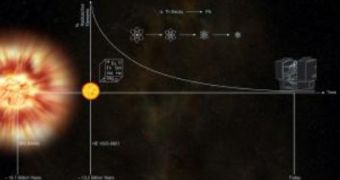Astronomers have recently measured the age of a star located in our Galaxy and discovered that it's a real fossil in space, being 13.2 billion years old. For comparison, the entire Universe, from the Big Bang, is only 13.7 billion years old, a very small difference in cosmic time.
The star's name is HE 1523-0901 and its age was calculated using ESO's Very Large Telescope (VLT). The "living" fossil was found to be born at the very dawn of time itself.
"Surprisingly, it is very hard to pin down the age of a star", the lead author of the paper reporting the results, Anna Frebel, explains. "This requires measuring very precisely the abundance of the radioactive elements thorium or uranium, a feat only the largest telescopes such as ESO's VLT can achieve."
The method used to calculate the age of the star is not very different from the carbon-14 dating method used by archaeologists on Earth. They use it to determine the age of terrestrial fossils with a precision of up to a few tens of thousands of years.
To apply this method to a cosmic object, they studied the radioactive and unstable isotopes that decay in time. The faster the decay, the less will be left of the radioactive isotope after a certain time, so the greater the abundance difference will be when compared to a stable isotope and the more accurate is the resulting age.
"Actual age measurements are restricted to the very rare objects that display huge amounts of the radioactive elements thorium or uranium," says Norbert Christlieb, co-author of the report.
When studying the star HE 1523-0901, astronomers found large amounts of these elements, but they also used three neutron-capture elements, europium (Eu), osmium (Os) and iridium (Ir).
"Until now, it has not been possible to measure more than a single cosmic clock for a star. Now, however, we have managed to make six measurements in this one star"," says Frebel.
The six "clocks" of the star indicated 13.2 billion years, proving that this star clearly formed very early in our own Galaxy, which must also have formed very soon after the Big Bang.

 14 DAY TRIAL //
14 DAY TRIAL //